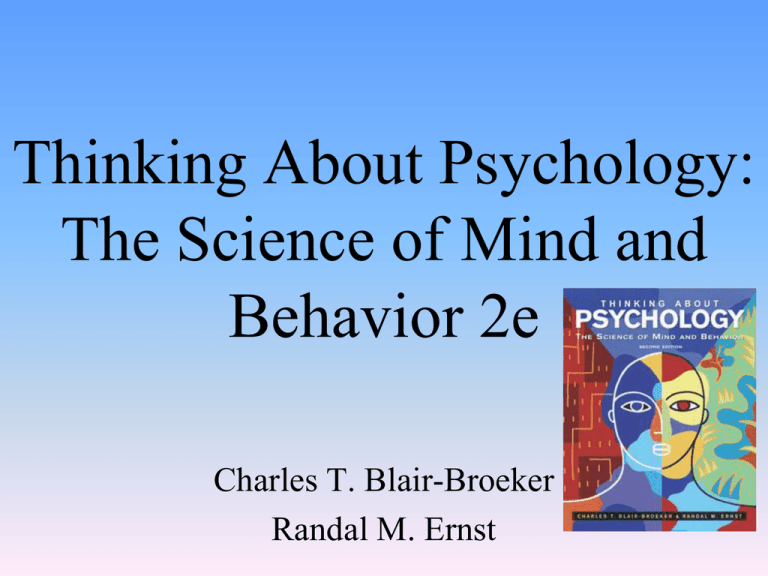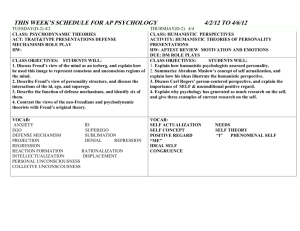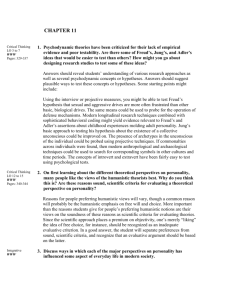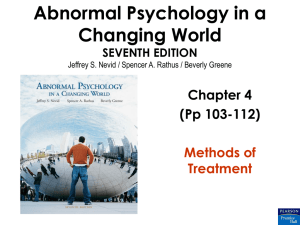Psychology - HGunnWikiMHS
advertisement

Thinking About Psychology: The Science of Mind and Behavior 2e Charles T. Blair-Broeker Randal M. Ernst Developmental Domain Personality Chapter Module 17 Psychodynamic and Humanistic Perspectives on Personality Personality • Individual’s characteristic pattern of thinking, feeling, and acting Module 17: Psychodynamic and Humanistic Perspectives The Psychodynamic Perspective Sigmund Freud (1856-1939) • Founder of psychoanalysis • Proposed the first complete theory of personality • A person’s thoughts and behaviors emerge from tension generated by unconscious motives and unresolved childhood conflicts. Neurologist, not a Psychologist • Freud was not a psychologist. At the time he received his education, there were only one or two “psychology” programs in the world. • Freud was trained as a neurologist and treated mostly women for what were called “neuroses”. • The so-called neuroses typically had a sexual component because the Victorian social norm of sexual inhibition was popular when Freud began practicing medicine. Psychoanalysis • Freud’s theory of personality • Also a therapeutic technique that attempts to provide insight into one’s thoughts and actions • Does so by exposing and interpreting the underlying unconscious motives and conflicts Psychodynamic Perspective • View of personality that retains some aspects of Freudian theory but rejects other aspects • Retains the importance of the unconscious thought processes • Less likely to see unresolved childhood conflicts as a source of personality development Do you Know These Terms? • • • • • • Fixated Repressed Regressed Anal-retentive Oedipus complex Rationalize • Activity: Fifteen Freudian Principal Statements, Handout 17-4 Module 17: Psychodynamic and Humanistic Perspectives The Psychodynamic Perspective: Freud’s View of the Mind Free Association • Method of exploring the unconscious in which the person person relaxes and says whatever comes to mind, no matter how trivial or embarrassing Try it: free associate with each of the following words, write down the first word that comes to mind. • • • • • • • Cat Mitten Glass Tangerine Red Brick Button • So, do any of these words seem to reveal any hidden feelings you might have about something or someone in your life? • Would you want people to read meaning into this list of freely-associated words? Why or why not? Conscious Mind • The thoughts and feelings one is currently aware of Preconscious Mind • Region of the mind holding information that is not conscious but is retrievable into conscious awareness • Holds thoughts and memories not in one’s current awareness but can easily be retrieved Unconscious Mind • Region of the mind that is a reservoir of mostly unacceptable thoughts, wishes, feelings, and memories The Mind According to Freud Module 17: Psychodynamic and Humanistic Perspectives The Psychodynamic Perspective: The Id, Ego, and Superego 90% of the Iceberg Rests Beneath the Surface of the Water. • Freud believed that people were like icebergs – only allowing a bit of their personalities to be seen and hiding the rest from others. • Do you, yourself, show your true self to others? – Do you feel others around you know “the real you”? Why or why not? – What types of things do people keep hidden from casual friends & acquaintances? Why? – What types of things DO you share? Why? Freud’s Concept of the “Id” • The part of personality that consists of unconscious, psychic energy • Strives to satisfy basic sexual and aggressive drives • Operates on the “pleasure principle” demanding immediate gratification • Is present from birth Freud’s Concept of the “Superego” • The part of personality that consists of internalized ideals and standards • One’s conscience; focuses on what the person “should” do Freud’s Concept of the “Ego” • Largely conscious, “executive” part of personality that mediates among the demands of the id, superego, and reality • Operates on the reality principle satisfying the id’s desires in ways that will realistically bring pleasure rather than pain Brother Cartoons • Devil = the id • Angel = superego • Character = ego • Each would give the character advice, and that character would have to choose to whom it would listen. The devil, the id, encourages more licentious behavior; the angel, representing the superego, advises obedience to moral and ethical principles. The character, the ego, must take in both types of advice and make the most realistic decision. Examples • • • • • • A Simpsons episode features Bart suffering from a moral dilemma, complete with good and bad angels; the good angel knocks out the bad angel by throwing its halo like Captain America's shield, at which point Bart remarks, "It figures that my conscience would suffer from mood swings". In Disney's version of Pinocchio, Jiminy Cricket is hired by the "Blue Fairy" to act as Pinocchio's conscience. Note that "Jiminy Cricket" has the same initials as "Jesus Christ." This is intentional, as at the time this was the acceptable replacement term. Pirates Of The Caribbean: At World's End gives Jack Sparrow two smaller Jacks that appear to come out of his hair. Instead of the traditional good and evil, the dilemma is between rum and immortality without rum, at least until they point out to him that having rum once every ten years for eternity is still more rum than having it every day of a normal lifetime. The 30 Rock episode "Black Tie" played with this in a rather surreal way. Pete is about to cheat on his wife when Kenneth pops in through a vent and tells him not to. Then Tracy pops through another vent, so that he's framed above Pete's other shoulder, and argues with Kenneth. Finally, Pete turns to dramatically declare "I'm sorry, I can't do this - I love my wife!" http://watch.thecomedynetwork.ca/#clip120030 The Cat in the Hat Group Activity and then individual assignment, psychoanalyzing someone. Module 17: Psychodynamic and Humanistic Perspectives The Psychodynamic Perspective: Defense Mechanisms Defense Mechanisms • In psychoanalytic theory, the ego’s protective methods of reducing anxiety by unconsciously distorting reality Repression • Puts anxiety-arousing thoughts, feelings, and memories into the unconscious mind • The basis for all other defense mechanisms Regression • Allows an anxious person to retreat to a more comfortable, infantile stage of life Denial • Lets an anxious person refuse to admit that something unpleasant is happening Reaction Formation • Reverses an unacceptable impulse, causing the person to express the opposite of the anxiety-provoking, unconscious feeling • Ex: if you are interested in someone who is unavailable, you find yourself feeling a curious dislike (instead of fondness). Projection • Disguises threatening feelings of guilty anxiety by attributing the problems to others • Ex: I don’t trust him becomes “I don’t trust myself”, or the thief thinks everyone else is a theif. Rationalization • Displaces real, anxiety-provoking explanations with more comforting justifications for one’s actions • Ex: the smoker rationalizes that she just smokes “to look older”, or “only when I’m with my friends.” Displacement • Shifts an unacceptable impulse toward a more acceptable or less threatening object or person • Ex: the company owner becomes upset and yells at the manager, who yells at the clerk, who goes home and yells at the kids and the kids kick the dog. All have been displacing (except the dog). Defense Mechanisms Create a Narrative • In your group, create a narrative (or story) using the defense mechanisms as characters. Each mechanism should behave according to the description given in your text. • Ex: Ruby Repression might be trying to banish feelings she’s having, that are causing her anxiety and guilt, so she enlists the help of her friends. Skits • Enact the skit that your group is assigned. • You will have 10 minutes to review before you act it out. • The others will guess which defense mechanism you are illustrating and why they give the answer they do. • Handouts 17-6a and 17-6b • Also, handout 17-5 “Defense Mechanisms” Module 17: Psychodynamic and Humanistic Perspectives The Psychodynamic Perspective: Freud’s Psychosexual Stages Psychosexual Stages • In Freudian theory, the childhood stages of development during which the id’s pleasure seeking energies focus on different parts of the body • The stages include: oral, anal, phallic, latency, and genital • A person can become “fixated” or stuck at a stage, leading to problems as an adult Oral Stage • Pleasure comes from chewing, biting, and sucking. • Weaning can be a conflict at this stage. • 1-18 months • The person weaned too early would show signs of oral fixation later in life – always putting objects in the mouth, chain smoking, or overeating. Freud’s Stages of Development Anal Stage • Gratification comes from bowel and bladders functions. • Potty training can be a conflict at this stage. • 18-36 months • Fixation occurs in one of two ways: 1) if potty training occurs too early, a person can become anal retentive (overly neat and fussy about organization and details) and 2) if potty training is not encouraged or allowed to happen haphazardly, the person can become anal-expulsive (overly messy) Freud’s Stages of Development Phallic Stage • The pleasure zone shifts to the genitals. • Boys cope with incestuous feelings toward their mother and rival feelings toward their dad (Oedipus conflict). • Freud based his theory on the case study of a little boy named Hans. Five-year-old Hans had developed a fear of horses, which Freud believed was actually a displaced fear of his father. In addition, he had developed castration anxiety, a fear of having his penis cut off because his parents had told him if he continued to play with it, it would be cut off. He had noticed that his sister lacked a penis, so he concluded that his parents had cut her penis off. Freud’s Stages of Development Latency Stage • Sexual feelings are dormant. • Child identifies with and tries to mimic the same sex parent to learn gender identity. • Instead of fearing the same-sex parent, girls and boys start to “buddy up” to Mom and Dad, respectively. Freud called it the “identification process”. This theory offers one explanation of gender identity, which is our sense of what it means to be either male or female. Freud’s Stages of Development Genital Stage • Begins at puberty with the maturation of sexual interests • Freud believed that unresolved conflicts in any of the psychosexual stages could cause problems later in life. Freud’s Stages of Development Module 17: Psychodynamic and Humanistic Perspectives The Psychodynamic Perspective: Neo-Freudians Neo-Freudians • Followers of Freud’s theories but developed theories of their own in areas where they disagreed with Freud • Include Adler, Jung, and Horney Alfred Adler (1870-1937) • Neo-Freudian who thought social tensions were more important than sexual tensions in the development of personality • Believed psychological problems were the result of feelings of inferiority Inferiority Complex • According to Adler, a condition that comes from being unable to compensate for normal inferiority feelings • This is the origin of a label you’ve probably already heard. Carl Jung (Yoong)(1875-1961) • Neo-Freudian who believed that humans share a collective unconscious Collective Unconscious • Jung’s concept of a shared, inherited reservoir of memory traces from our ancestors • Information everyone knows from birth • Archetypes (AR-kuh-types) – universal symbols found in stories, myths, and art. • Ex: the shadow archetype is the darker, evil side of human nature. Supposedly, we hide this from the world and ourselves. Inherited Memory • Contemporary psychologists reject the notion of inherited memory. However, many believe that our shared evolutionary history has contributed to some universal behavior tendencies (like hiding our worst secrets from others), or dispositions (evil). Karen Horney (HORN-eye)(1885-1952) • Neo-Freudian who found psychoanalysis negatively biased toward women • Believed cultural/social variables are the foundation of personality development Neurosis • Horney fully developed the idea of neurosis, or a driving need for something or someone. She believed neuroses helped to make life bearable, giving us a sense of something to strive for. Only when people didn’t fulfill a need or became obsessed with a particular neurotic need did these become problematic and interfere with life. Ten Neurotic Needs, Three Categories 1) Compliance includes needs for affection, a partner, and simplifying one’s life. 2) Aggression includes needs for power, exploitation of others, prestige, personal admiration, and personal achievement. 3) Withdrawal includes needs for independence and perfection. Module 17: Psychodynamic and Humanistic Perspectives The Psychodynamic Perspective: Assessing Personality Projective Tests • Personality tests that provide ambiguous stimuli to trigger projection of one’s inner thoughts and feelings • Include: – Thematic Apperception Test (TAT) – Rorschach Inkblot Test Thematic Apperception Test (TAT) • Projective test in which people express their inner feelings and interests through the stories they make up about ambiguous scenes • The person makes up a story of a picture they are shown Rorschach Inkblot Test • Personality test that seeks to identify people’s inner feelings by analyzing their interpretations of 10 inkblots • Most widely used personality test • • Note: Hermann Rorschach was Swiss; couldn’t find a publisher for his book, which was poorly received. Died at 37 (appendicitis). Current controversy about the Rorschach being online! Make a Connection… • Remember the term Projective Tests by linking that term to Freud’s defense mechanism of projection – With projection, clients attribute their negative feelings to someone or something else, making it safer for them to have those types of feelings – Projective tests enable people to apply their feelings to a picture, which the analyst interprets to explain hidden feelings & experiences Module 17: Psychodynamic and Humanistic Perspectives The Psychodynamic Perspective: Evaluating the Perspective Updating Freud’s Theory • Most psychodynamic psychologists agree: – Sex is not the basis of personality. – People do not “fixate” at various stages of development. – Much of a person’s mental life is unconscious. – People struggle with inner conflicts, and childhood experiences shape us. Module 17: Psychodynamic and Humanistic Perspectives The Humanistic Perspective Humanistic Psychology • Perspective that focuses on the study of conscious experience, the individual’s freedom to choose, and capacity for personal growth • Studies fulfilled and healthy individuals rather than troubled people Module 17: Psychodynamic and Humanistic Perspectives The Humanistic Perspective: Abraham Maslow and Self-Actualization Abraham Maslow (1908-1970) • Humanistic psychologist who proposed the hierarchy of needs • Believed selfactualization is the ultimate psychological need Hierarchy of Needs • Maslow’s pyramid of human needs, beginning at the base with physiological needs, proceeding through safety needs and then to psychological needs • Higher-level needs won’t become active until lower-level needs have been satisfied. Self-Actualization • According to Maslow, the ultimate psychological need • Arises after basic physical and psychological needs are met and selfesteem is achieved • The motivation to fulfill potential Self-Actualization • Characteristics include: – Self aware and self accepting – Open, spontaneous, loving, and caring – Not paralyzed by other’s opinions – Focused on a particular task – Involved in few deep relationships – Have been moved to peak experiences Maslow’s Hierarchy of Needs Maslow’s Hierarchy of Needs Maslow’s Hierarchy of Needs Maslow’s Hierarchy of Needs Maslow’s Hierarchy of Needs Why Aren’t More Adults SelfActualized, if the Tendency is Innate? 1. 2. 3. 4. It’s the weakest of need and the most easily impeded. Jonah Complex: we doubt our own abilities (and aren’t courageous enough) The cultural environment stifles self-actualization (ex: definitions of “manliness” prevent the male child from developing traits of sympathy, kindness, and tenderness, all of which characterize the selfactualized person. Childhood experiences may inhibit personal growth. Children from warm, secure, friendly homes are more likely to choose experiences that lead to personal growth. Excessive control and coddling is harmful but so is excessive permissiveness. Debunk Maslow? • Can you come up with experiences that contradict Maslow’s hierarchy of needs? – Can students learn when they are hungry? – Why do people go on hunger strikes to protest in favor of a cause they believe in? – Why are there such things as “starving artists”? Module 17: Psychodynamic and Humanistic Perspectives The Humanistic Perspective: Carl Rogers and the Person-Centered Approach Carl Rogers (1902-1987) • Humanistic psychologist who stressed the importance of acceptance, genuineness, and empathy in fostering human growth Unconditional Positive Regard • According to Rogers, an attitude of total acceptance toward another person Genuineness • Freely expressing one’s feelings and not being afraid to disclose details about oneself Empathy • Sharing thoughts and understanding • Listening and reflecting the other person’s feelings Module 17: Psychodynamic and Humanistic Perspectives The Humanistic Perspective: Assessing Personality and the Self Humanistic Measures • Humanistic measures of personality center on evaluating a person’s self concept--all of our thought and feelings about ourselves • Answer the question “Who Am I?” Module 17: Psychodynamic and Humanistic Perspectives The Humanistic Perspective: Evaluating the Perspective Evaluating Humanism • Humanism has influenced therapy, child-rearing, and the workplace • Laid the foundation for positive psychology Evaluating the Humanistic Perspective • Unintentional Effects: – Mistakenly interpreted unconditional positive regard for children as meaning we should never offer constructive criticism to a child, or, worse, never tell a child no. – Critics also point out that many humanistic terms are vague and hard to define precisely so that other researchers can test them: spontaneous, loving, productive. – It did, however, lay the ground for the positive psychology movement of the past decade. Many researchers are studying the human strengths and virtues, like courage and hope, of healthy people, rather than just the disorders of those who are not psychologically healthy. Self-Ratings & Self-Concepts • Try some self-ratings quizzes. • Handouts 17-7, 17-8, 17-9, 17-10, 17-11, 17-12 Comparing Forces in Psychological Thought • Two different views about human behavior come together in this module and present opposed views on human nature, causes of mental illness, and goals of therapy. Yet, they share some similarities. – Psychodynamic Perspective believes people are born with a strong, selfish id and develop a sense of morality and reality. – Humanistic Psychologists believe people are naturally good & full of potential, which must be drawn out with love and empathy. – Plus, Freudian thinkers sought to uncover the past while humanistic thinkers were concerned with helping clients discover how they could maximize their present circumstances. Videos • The Mind Hidden and Divided (Discovering Psychology) • Personality • Freud Under Analysis (Nova) • Feel Good About Failure (20/20) • The Truth About Lies (PBS, The Public Mind). The End Name of Concept • Use this slide to add a concept to the presentation Name of Concept Use this slide to add a table, chart, clip art, picture, diagram, or video clip. Delete this box when finished








